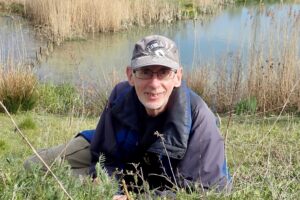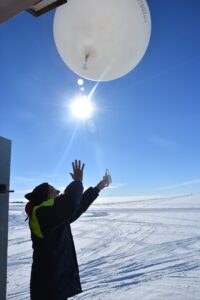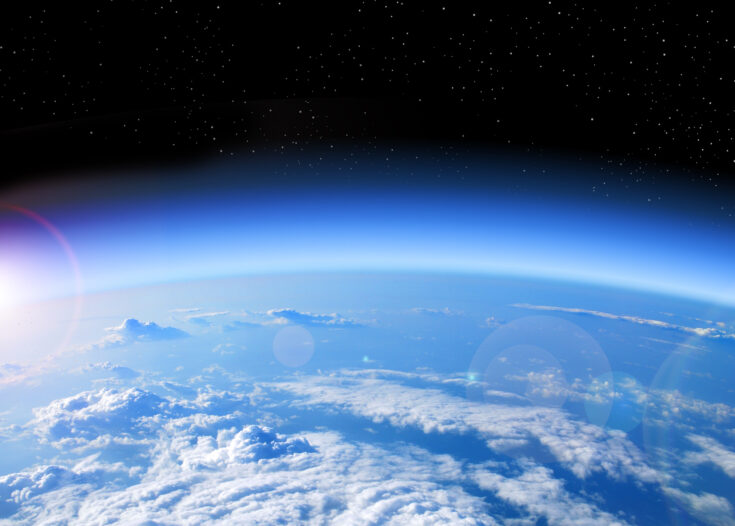In 1977, 24-year-old Jonathan Shanklin saw an advert for a job at British Antarctic Survey (BAS), which read:
Wanted: physicist with an interest in meteorology and programming skills.
Feeling he ticked the boxes, Shanklin applied and was offered the role.
Scrawling data on sheets of paper
At first, one of Shanklin’s main tasks was checking and correcting all of the data from the Dobson ozone spectrophotometer in Antarctica. This instrument measures the amount of UV light reaching Earth, providing an accurate picture of how much ozone there is in the atmosphere. There was a huge backlog, as scientists had until then simply scrawled the data on sheets of paper.
About this time, BAS was planning to have an open day at their Cambridge headquarters to show the latest Antarctic science to eminent scientists, politicians and the public.
Shanklin recalls:
There had been concern at the time that exhaust gases from Concorde (the supersonic passenger aircraft), or chlorofluorocarbons (CFCs) from spray cans, might damage the ozone layer.
Being an ignorant physicist, I thought this unlikely, so decided to present that year’s data and compare it with values my boss had computed from a decade earlier. I expected them to be the same, so Concorde would be able to keep flying and the public could keep using their spray cans.
The only problem was, they weren’t the same.
A decline in spring ozone
Surprised and slightly alarmed, Shanklin continued to work through the backlog to try and see if that year was just a one-off.
It wasn’t. The results were clear: since the late 1970s there had been a systematic decline in the amount of spring ozone. By 1984, the ozone layer over Halley Research Station in Antarctica was only about two-thirds as thick as it had been in earlier decades.
At first Shanklin didn’t realise the enormous implications of the finding.
I thought it was something that was perhaps peculiar to Antarctica, and only of scientific interest.
Nevertheless, Shanklin began preparing a paper for the science journal Nature, including a possible chemical mechanism to explain the observations. Shanklin’s departmental boss, eminent physicist, Joe Farman, thought it was essential for such a significant finding to be published in the journal.
It was released in May 1985 and provided a considerable shock to the world.
Confirming the findings
An independent team of scientists quickly confirmed the findings. Satellites showed that the ozone hole extended over a vast region of 20 million square kilometres.
Researchers quickly agreed that compounds called CFCs, often used in aerosol cans and cooling devices such as fridges, must be responsible.
The ozone layer above the Antarctic is especially sensitive to CFCs because of its unique geography. Antarctica is a mountainous continent surrounded by vast open ocean.
These two factors combined cause temperatures in the ozone layer to plummet below -78°C during the Antarctic polar winter.
Clouds form, and on the surface of those clouds chemical reactions take place converting chlorine from the CFCs into an active form. This active chlorine breaks down ozone when the sun returns in the spring.
Political action
The research led directly to the 1987 Montreal protocol. This was an agreement to freeze production and consumption of ozone-depleting substances at then current rates.
Later amendments tightened these restrictions, with global CFC production and consumption phased out by 2010.
The protocol continues to be updated as new evidence comes to light about the impact of CFCs, and their replacements, on the ozone layer. For instance, in 2016, research funded by the Natural Environment Research Council led to hydrofluorocarbons (HFCs), potent climate gases, being added to the list of controlled substances. There was an agreement to phase-down their use over the next 30 years.
Now the protocol is widely recognised as among the most successful international environmental agreements of all time. The Antarctic ozone hole is slowly healing, although as CFCs have atmospheric lifetimes of 50 years or more, the atmosphere will not fully recover until after 2070, even in the absence of further emissions.
Shanklin says:
It is humbling to think that industry across the world has had to change because of what seemed to be a small discovery over an obscure part of Antarctic that most people had never heard of.
Impact
The impact that the finding had cannot be overstated. A 2015 analysis by Deloitte estimates that if Shanklin, Farman and Gardiner hadn’t discovered the hole in the ozone layer when they did, it would have delayed the Montreal protocol by five to 10 years.
Without the protocol, the UN Environment Programme has estimated that the number of global skin cancer cases would have been 14% higher by 2030. This would cost almost 300 lives per year from skin cancer in the UK alone.
What’s more, a recent UKRI-funded study by an international team of scientists found that if CFCs had not been banned in the late 1980s, their continued use would have caused average global air temperatures to rise by an additional 2.5 C by the end of the century. This is on top of existing warming.
The reasons for this are twofold. CFCs are potent greenhouse gases in their own right, and so would contribute directly to climate change. UV radiation also harms plants, stopping them from growing and locking up carbon dioxide from the atmosphere.
Long term monitoring of the environment
The scientists estimated that without the Montreal Protocol, by the end of this century there would be:
- 325 to 690 billion tonnes less carbon stored in forests, other vegetation and soils
- this reduction in offsetting of CO2 emissions would have resulted in a further rise of 0.8°C in global temperatures, thereby accelerating existing rates of global warming caused by fossil fuel burning
- an extra 115 to 235 parts per million of carbon dioxide in the atmosphere, relative to pre-industrial levels.
Shanklin explains:
With the ozone hole it was something that was absolutely clear cut, you could show politicians a picture of the Antarctic ozone hole.
Because increased UV light was also linked to incidences of skin cancer, it was a public health issue, and so political effort was harnessed incredibly rapidly.
The story highlights the importance of conducting long-term monitoring of the environment, and taking urgent action when it is needed.
Further information
Interview: preserving the ozone layer, then and now

Credit: Jonathan Franklin
For International Day for the Preservation of the Ozone Layer, we catch up with two scientists whose work has been instrumental in preserving this vital shield for four decades.
It’s 36 years since scientists first discovered the hole in the ozone layer, an invisible shield which absorbs harmful UV rays from the Sun. Without which, complex life on Earth would not exist.
The finding spurred a whole environmental movement in the 1980s and led to the total ban of CFCs (the chemicals responsible for destroying ozone).
However the story didn’t end there. Researchers continue to monitor the ozone layer to ensure it continues to heal.
We speak about the impact of the finding with:
- Jonathan Shanklin, one of the scientists behind the discovery of the hole
- Anna Jones, Interim Director of Science at British Antarctic Survey (BAS).
Jonathan, please can you tell us a bit about how you first discovered the hole in the ozone layer?
Jonathan says:
When I first joined BAS part of my job was to supervise and check the ozone data coming back from the Dobson ozone spectrophotometer in Antarctica.
The Dobson ozone spectrophotometer in Halley measures the amount of UV light reaching Earth, providing an accurate picture of how much ozone there is in the atmosphere.
When Jonathan started there was a huge backlog in uploading the data to the system, as scientists had until then simply scrawled the readings on sheets of paper.
At about that time we had an open day where members of the public were invited to come and learn about all of the research we were conducting in Antarctica. There had been a lot of concern that exhaust gases from Concorde might destroy the ozone layer, or spray cans might destroy the ozone layer.
Being an ignorant physicist, I thought if I took this year’s ozone data and compared it with readings from twenty years earlier it would be the same, and so people needn’t worry. But the readings weren’t the same and so it required following up.
Shanklin continued to work through his backlog to try see if that year was just a one off.

Credit: Jonathan Franklin
It wasn’t. The results were clear. Since the late 1970s there had been a systematic decline in the amount of spring ozone. By 1984, the ozone layer over Halley was only about two-thirds as thick as it had been in earlier decades.
Shanklin’s findings were published in a seminal Nature paper in May 1985. The research led directly to the 1987 Montreal protocol. This is an agreement to freeze production and consumption of ozone-depleting substances at then-current rates.
Later amendments tightened these restrictions, with global CFC production and consumption phased out by 2010.
Now the Antarctic ozone hole is slowly healing, although as CFCs have atmospheric lifetimes of 50 years or more, the atmosphere will not fully recover until after 2070. This is even in the absence of further emissions.
Anna, in your opinion, what impact did the original discovery of the hole in the ozone layer have on the world?
It had an absolutely massive impact. It triggered the environmental movement of the 1980s. It put environmental protection high up the political agenda, but it also provided a framework in the shape of the Montreal protocol for how to tackle global environmental problems.
What was very clever about the Protocol was that although it was signed in the 1980s, there was a clause in it that said it had to be reviewed on a regular basis. So as new evidence came to light about other ozone depleting substances, they could also be included.
For instance, in 2016, research by NERC led to HFCs (potent climate gases) being added to the list of controlled substances with an agreement to phase-down their use over the next 30 years.
It really demonstrated the type of legislation needed to tackle global environmental problems, which is exactly what we need now with climate change.
Jonathan, do you agree?
The discovery had worldwide impact. It’s still having that impact. Because even the smallest changes in ozone readings can reveal interesting things. Recently there was a discovery that CFCs were not declining as rapidly as they should. That was traced back to a source from China, and the Chinese government took action and it is now back on track to where it should be.
It’s amazing that world governments do respect the protocol. It is humbling to think that industry across the world has had to change because of what seemed to be a small discovery over an obscure part of the Antarctic that most people had never heard of.
Anna, can you tell us about your background and the research you conduct in Antarctica?
I’m acting Director of Science at BAS, but I’m an atmospheric chemist by background. I did a chemistry degree at the University of East Anglia, and then I did my PhD at Cambridge. My PhD was actually looking at the effect of supersonic aircraft on the ozone layer.
During my career I’ve done a lot of research on the stratosphere, the upper atmosphere where the hole in the ozone was discovered. However, I’ve also done a lot more recently in the troposphere, the lowest level of the atmosphere.
How does your research feed into efforts to heal the ozone layer?
As part of my role, I oversee the long-term observations of ozone at Halley station.
To get a full picture of the ozone layer and how it is changing, scientists use different pieces of information. They combine ground-based measurements of the ozone column, like those measured at Halley, with atmospheric measurements taken at different heights with a balloon. They also use satellite measurements, so all of these different pieces form a part of the jigsaw puzzle.
This work is incredibly important because there are people who say the ozone problem is solved, we have banned these different ozone depleting chemicals. But, actually the story is not over at all. As Jonathan says, recently it was discovered that CFCs were still being produced illegally.
It’s vital that we continue to monitor the ozone layer until we have complete confidence that it is going to absolutely go back to where it was before. The long-term measurements of ozone are incredibly important because the recovery is far from finished.
Scientists think the hole in the ozone layer will disappear completely by 2075. Are there any challenges or barriers preventing this happening?
Anna says:
One challenge is if you have illegal production of ozone depleting chemicals.
However there might also be new chemicals that are manufactured or synthesised that turn out to be ozone depleting substances.
The other thing concerns what is happening to temperatures in the stratosphere. Although greenhouse gases cause global warming overall, they actually cool the upper atmosphere. Those conditions exacerbate ozone loss.
Anything that we do to tackle global warming and climate change will reduce the cooling of the stratosphere, and that will help the ozone layer recover quicker.
Jonathan, why do you think it is important to continue to monitor the ozone?
You need long term monitoring to confidently see how things have changed. If you only making spot measurements and don’t know what changes have happened in the interval, then you can’t tell if your change is a one-off event or something systematic.
That’s where we really had the edge over everyone else when we made the ozone hole discovery, as we had continuous data from Halley station going back to 1956.
These long-term measurements do have a cost and they don’t perhaps deliver cutting edge science, but if we don’t know exactly what the past has done we will have no idea of what the future holds.
The Montreal protocol is widely seen as the most successful environmental protection agreement to date. Jonathan why do you think it was it so successful?
I think it was the fact that it was absolutely clear cut. You could show politicians a picture of the Antarctic ozone hole, and so they were very quickly enabled to take action.
There were also alternatives to CFCs that were already available. Because increased UV light was linked to increased incidences of skin cancer, the word cancer made it a public health issue and so political effort was harnessed incredibly rapidly.
Anna, what lessons can we draw from the Montreal protocol when trying to combat climate change today?
There are important parallels between the Montreal protocol and legislation needed to solve climate change, most obviously, that both need significant international co-operation.
But the climate change problem is much more complex, given our current almost global reliance on fossil fuels.
The hope is that the Montreal protocol provides some assurance that solutions to global environmental problems can be found, even if they are not easy.
Jonathan agrees:
The Montreal protocol has provided an exemplar of how things should operate.
If we could adopt the same approach with climate change and proceed just as rapidly then we wouldn’t be in quite such a bad position as we are now, as we should have started taking action on climate change decades ago.
Top image: Credit: studio023 / Getty Images

